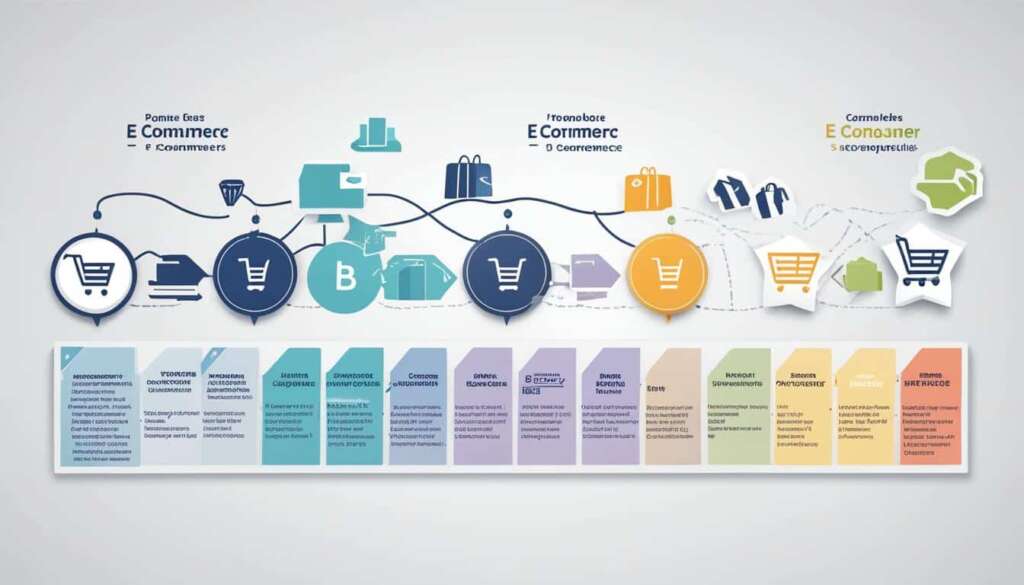Table of Contents
E-commerce refers to the buying and selling of goods and services online. It has seen significant growth in recent years, with e-commerce transactions falling into different types such as B2B, B2C, C2C, and C2B. The popularity of e-commerce platforms like Amazon and eBay has contributed to the growth of online retail. E-commerce works by customers accessing online stores through their devices, browsing and placing orders. The order is then processed by a central computer and sent to the warehouse for dispatch.
There are various types of e-commerce business models, each catering to different parties participating in online transactions. The advantages of e-commerce include around-the-clock availability, speed of access, wide selection, easy accessibility, international reach, and lower costs. However, there are also disadvantages, such as limited customer service, inability to see or touch products before purchase, wait time for shipping, and security issues.
How to Teach ICT E-commerce Effectively?
When teaching ICT e-commerce, it is important to focus on practical skills and real-life examples. Students should be introduced to the different types of e-commerce and the processes involved in online transactions. Teachers can use case studies and interactive exercises to illustrate the concepts and engage students. It is also crucial to teach students about the advantages and disadvantages of e-commerce, and how to navigate potential security risks.
Students should learn about e-commerce platforms, payment processing applications, and the role of databases in managing inventory levels. Practical projects and simulations can help students apply their knowledge and develop critical thinking skills. It is important to stay updated with the latest trends and technologies in e-commerce to provide relevant and valuable instruction to students.
Teaching Strategies for ICT E-commerce
Implementing effective teaching strategies is key to ensuring student comprehension and engagement in ICT e-commerce. Here are some strategies to consider:
- Use real-life examples and case studies to illustrate concepts and make them more relatable.
- Incorporate interactive exercises and activities to encourage active participation and hands-on learning.
- Encourage discussion and critical thinking by posing thought-provoking questions and scenarios.
- Provide opportunities for students to collaborate and work in groups, promoting teamwork and problem-solving skills.
- Utilize multimedia resources, such as videos and infographics, to enhance understanding and engagement.
“Effective teaching in ICT e-commerce involves creating a learning environment that encourages active participation, critical thinking, and practical application of knowledge.”
By employing these teaching strategies, educators can foster a deeper understanding of ICT e-commerce concepts and equip students with the necessary skills for success in the digital business world.
To further enhance the learning experience, teachers can also make use of educational resources and tools specifically designed for teaching ICT e-commerce. These resources may include online courses, educational websites, and interactive simulations that provide students with additional opportunities to practice and reinforce their understanding of e-commerce principles.
| Teaching Strategy | Description |
|---|---|
| Real-Life Examples | Illustrate concepts using relevant and relatable real-life examples to enhance understanding and applicability. |
| Interactive Exercises | Engage students in hands-on activities and simulations that allow them to actively participate and apply their knowledge. |
| Collaborative Learning | Promote teamwork and problem-solving skills by assigning group projects and encouraging collaborative learning. |
| Multimedia Resources | Utilize videos, infographics, and other multimedia tools to enhance comprehension and engagement. |
By implementing these teaching strategies and leveraging educational resources, educators can effectively teach ICT e-commerce and empower students with the digital business skills needed for success in the modern world.
Strategies for Teaching ICT E-commerce in the Classroom
Teaching ICT e-commerce in the classroom requires a combination of teaching strategies and classroom activities to keep students engaged. In order to effectively teach ICT e-commerce, educators should employ various techniques and approaches that encourage student participation and foster a deeper understanding of the subject matter.
1. Using Real-Life Examples and Case Studies
One effective strategy is to incorporate real-life examples and case studies into the lessons. By demonstrating how e-commerce is applied in practical situations, students are able to grasp the concepts more easily and see the relevance of what they are learning. This approach helps to bridge the gap between theory and practice, making the subject matter more relatable and engaging.
2. Incorporating Hands-On Activities and Simulations
Hands-on activities and simulations provide students with practical experience in navigating e-commerce platforms and conducting online transactions. By providing opportunities for students to actively participate in simulated e-commerce scenarios, they develop a better understanding of the processes involved and gain valuable problem-solving skills.
3. Encouraging Exploration of E-commerce Platforms
Teachers should encourage students to explore various e-commerce platforms and analyze their features. This hands-on approach allows students to familiarize themselves with the functionalities of different platforms and understand their strengths and limitations. By doing so, students develop a critical mindset and are better equipped to evaluate and make informed decisions in the e-commerce landscape.
4. Assigning Group Projects and Role-Playing Activities
Group projects and role-playing activities help to promote collaboration and teamwork among students. By assigning tasks that require students to work together, such as creating a mock e-commerce website or developing a marketing plan for an online store, students learn valuable communication and problem-solving skills while gaining a deeper understanding of the complexities of e-commerce.
5. Using Multimedia Tools and Interactive Technologies
Multimedia tools and interactive technologies can enhance the learning experience by presenting information in a visually appealing and interactive manner. Videos, interactive presentations, and online quizzes engage students and facilitate active learning. These tools also provide opportunities for students to explore different e-commerce concepts and scenarios in a dynamic and engaging way.
6. Providing Opportunities for Student Website Creation
One effective way to engage students and encourage hands-on learning is to provide opportunities for them to create and manage their own e-commerce websites or online stores. This allows students to apply their knowledge and skills in a practical setting, gaining valuable experience in website design, product management, and customer interaction.
7. Inviting Guest Speakers from the E-commerce Industry
Bringing in guest speakers from the e-commerce industry can provide valuable insights and experiences for students. Industry professionals can share their expertise and firsthand knowledge, giving students a deeper understanding of the practical aspects of running an e-commerce business. This also exposes students to potential career paths and expands their network of industry connections.
By implementing these strategies, teachers can create a dynamic learning environment that promotes active learning and prepares students for the digital business world. Through a combination of real-life examples, hands-on activities, exploration of e-commerce platforms, group projects, multimedia tools, student website creation, and guest speakers, educators can engage students and equip them with the necessary skills and knowledge in ICT e-commerce.

Challenges and Opportunities in Teaching ICT E-commerce
Teaching ICT e-commerce presents both challenges and opportunities for educators. The rapidly evolving nature of the e-commerce industry requires teachers to stay updated with the latest trends and technologies. This constant change can be a challenge, but it also offers exciting opportunities for teachers to keep their lessons relevant and engaging.
One of the significant challenges teachers face is the digital skills gap among students. Many students may have limited knowledge and experience in using e-commerce platforms and tools. As educators, it is imperative to bridge this skills gap and equip students with the necessary digital business skills for their future careers.
By providing hands-on experience and practical projects, teachers can help students develop essential skills in e-commerce. This can include tasks such as creating their own online stores, managing inventory, and understanding the customer journey in an e-commerce transaction.
Industry insights play a crucial role in teaching ICT e-commerce. By collaborating with industry professionals and organizations, teachers can expose their students to real-world experiences and connect them with potential employers. Guest speakers from the e-commerce industry can share their insights and provide valuable information about the challenges and opportunities students may encounter.
Adapting teaching methods and curriculum to meet the changing demands of the e-commerce industry is vital. As technologies and consumer behaviors continue to evolve, it is essential for teachers to stay ahead and prepare students for the digital business world. This includes incorporating interactive technologies, multimedia tools, and simulations into the classroom to enhance student learning experiences and engagement.
Challenges and Opportunities in Teaching ICT E-commerce Summary:
Teaching ICT e-commerce poses challenges due to the ever-changing industry landscape and the digital skills gap. However, these challenges offer opportunities for teachers to provide hands-on experience, practical projects, and industry insights to equip students with the necessary digital business skills. Collaboration with industry professionals and organizations creates real-world opportunities for students. Adapting teaching methods to meet industry demands ensures students are well-prepared for the dynamic e-commerce world.
Challenges and Opportunities in Teaching ICT E-commerce Table:
| Challenges | Opportunities |
|---|---|
| Rapidly changing e-commerce landscape | Staying updated with the latest trends and technologies |
| Digital skills gap among students | Bridging the gap and equipping students with digital business skills |
| Limited knowledge and experience in using e-commerce platforms and tools | Providing hands-on experience and practical projects |
| Adapting teaching methods and curriculum to meet industry demands | Preparing students for the dynamic e-commerce world |
| Collaboration with industry professionals and organizations | Real-world experiences and networking opportunities for students |
Resources for Teaching ICT E-commerce
Online Courses and Educational Websites
When it comes to teaching ICT e-commerce, there are numerous resources available that can greatly enhance the learning experience for students. Online courses and educational websites in particular offer a wealth of comprehensive lessons, tutorials, and interactive modules that cover various aspects of e-commerce.
These resources provide step-by-step guidance and practical examples, allowing students to gain a deeper understanding of the concepts and processes involved in e-commerce. Students can learn at their own pace, accessing the material from anywhere with an internet connection.
One notable advantage of online courses and educational websites is the ability to cater to different learning styles. Visual learners can benefit from engaging multimedia content, while auditory learners can listen to audio lectures and discussions. This variety of resources ensures that students can find the learning tools that suit their individual needs.

By incorporating online courses and educational websites into their teaching, educators can provide a dynamic and interactive learning experience for their students.
Industry Reports, Case Studies, and Research Papers
In addition to online courses and educational websites, teachers can also access industry reports, case studies, and research papers to stay informed about the latest trends and developments in the field of e-commerce. These resources offer valuable insights and real-world examples that can be shared with students to enhance their understanding.
“Industry reports provide valuable data and analysis on market trends, consumer behavior, and emerging technologies in e-commerce. Case studies showcase successful e-commerce businesses and their strategies, offering students practical examples to learn from. Research papers delve into the theoretical aspects of e-commerce, exploring topics such as online marketing, supply chain management, and cybersecurity. By incorporating these resources into their curriculum, teachers can provide a comprehensive and well-rounded education for their students.”
By incorporating these resources into their curriculum, teachers can provide a comprehensive and well-rounded education for their students.
Online Forums and Communities
Another valuable resource for teaching ICT e-commerce is online forums and communities. These platforms allow teachers to connect with other educators and share best practices in teaching ICT e-commerce. Discussions and exchanges of ideas can help teachers stay updated with the latest teaching methods and strategies.
Additionally, online forums and communities provide a space for teachers to seek advice, ask questions, and collaborate with others who have experience in teaching e-commerce. This sharing of knowledge and expertise fosters a supportive and collaborative environment that benefits both teachers and students.
Utilizing a Combination of Resources
In order to create a well-rounded and engaging learning experience for students, it is important for teachers to utilize a combination of resources. By incorporating online courses and educational websites, industry reports and case studies, and engaging in online forums and communities, teachers can provide a diverse range of learning opportunities for their students.
By leveraging these resources, teachers can ensure that their students are equipped with the knowledge and skills necessary to thrive in the ever-evolving world of e-commerce.
Conclusion
Teaching ICT e-commerce is crucial for equipping students with essential digital business skills. By implementing effective teaching strategies, focusing on practical skills, and utilizing relevant resources, teachers can create engaging learning experiences that prepare students for the ever-evolving e-commerce industry.
Despite the challenges in teaching ICT e-commerce, such as the rapidly changing nature of the industry and the digital skills gap, there are numerous opportunities for educators to bridge this gap and provide students with the necessary knowledge and experience. By staying updated with the latest trends and industry insights, teachers can ensure that their students are well-prepared for the digital business world.
It is important for educators to understand the advantages and disadvantages of e-commerce, teach students about different types of online transactions, and familiarize them with e-commerce platforms and tools. By incorporating real-life examples, hands-on activities, and practical projects, teachers can help students develop critical thinking skills and apply their knowledge to real-world scenarios.
Furthermore, utilizing resources such as online courses, educational websites, and industry reports can enhance the learning experience and provide students with valuable information on e-commerce practices. By adopting a comprehensive approach to teaching ICT e-commerce, educators can empower students with the digital business skills they need to succeed in today’s technology-driven world.
FAQ
What is e-commerce?
E-commerce refers to the buying and selling of goods and services online.
What are the different types of e-commerce?
The different types of e-commerce include B2B (business-to-business), B2C (business-to-consumer), C2C (consumer-to-consumer), and C2B (consumer-to-business).
How does e-commerce work?
E-commerce works by customers accessing online stores through their devices, browsing and placing orders. The order is then processed by a central computer and sent to the warehouse for dispatch.
What are the advantages of e-commerce?
The advantages of e-commerce include around-the-clock availability, speed of access, wide selection, easy accessibility, international reach, and lower costs.
What are the disadvantages of e-commerce?
The disadvantages of e-commerce include limited customer service, inability to see or touch products before purchase, wait time for shipping, and security issues.
How can I teach ICT e-commerce effectively?
Teaching ICT e-commerce effectively involves using real-life examples and case studies, incorporating hands-on activities and simulations, encouraging exploration of e-commerce platforms, assigning group projects, using multimedia tools, and providing opportunities for students to create their own online stores.
How can I engage students in teaching ICT e-commerce?
To engage students in teaching ICT e-commerce, you can incorporate hands-on activities and simulations, assign group projects and role-playing activities, use multimedia tools and interactive technologies, and invite guest speakers from the e-commerce industry.
What are the challenges in teaching ICT e-commerce?
The challenges in teaching ICT e-commerce include the rapidly changing nature of the e-commerce landscape and the digital skills gap among students.
What are the opportunities in teaching ICT e-commerce?
The opportunities in teaching ICT e-commerce include filling the digital skills gap, preparing students for future careers, providing hands-on experience and practical projects, and collaborating with industry professionals and organizations.
What resources are available for teaching ICT e-commerce?
There are various resources available for teaching ICT e-commerce, including online courses, educational websites, industry reports, case studies, research papers, online forums, and communities.













